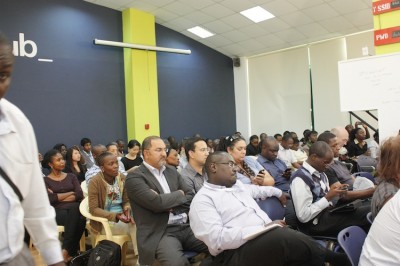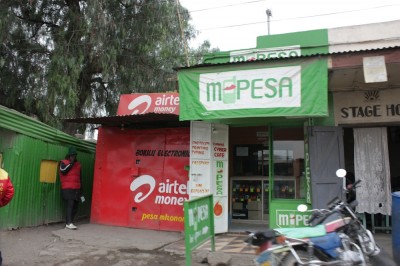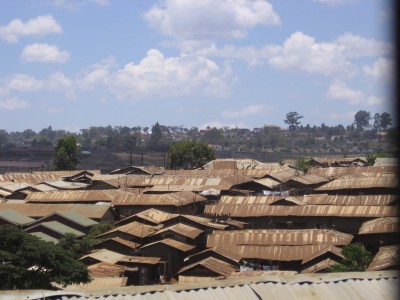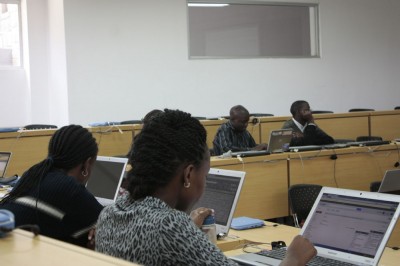Archive for the ‘Business’ Category
Mobile in East Africa. Is Reality Finally Getting Through?
Last week, an illustrious panel was joined by a reasonably sized audience at the iHub in Nairobi for a no-holds-barred discussion on the question is the Silicon Savannah hype or reality? Andrea Bonstedt triggered the discussion earlier in the week with an article published in The Star that resulted in animated discussions online. Sitting on the panel with Conrad Akunga and Njeri Rionge, she clarified her position on “Not every techie is an entrepreneur”. There’s a good summary of the evenings discussions on the iHub blog and in this follow-up piece by Andrea.
General consensus by the panel was that there’s still a long way to go and more to be done to improve the start-up ecosystem in Kenya. In conversations with a few private equity fund managers over the last week, Andrea’s claims were supported; there is still very little potential within the sector for fund managers to grow their pipelines from tech startups.
Meanwhile, inMobi announced it was scaling down its international operations and closing down offices in Africa and Russia. These markets will now be served by their London office. This at a time when the numbers show mobile penetration as rising exponentially on the continent. In the face of declining ARPU there’s increasing demand for data across Africa and the globe but the growth of smartphones on the continent is still slow. One plus one should equal two. Rising mobile penetration plus increasing demand for data should mean (somewhere in there) that there’s huge potential in the short term for businesses providing content and services on mobile via the internet. In my opinion, the potential is probably bigger than any commentator can say. It’s my view that the problem is in the timing. Apparently, users on the continent are on their own clock and exhibiting online behavior that deviates sufficiently from the norm common in the west as to make it less attractive for businesses like inMobi to justify a physical presence here.
Within this hype-vs-reality quandary lies a question which, due to inadequate answers, is probably one of the biggest reasons tech startups on the continent struggle. What do users in the mass market do with their mobile phones and how do they do it? A study by iHub Research funded by infoDev takes a stab at this problem from a high level perspective providing entrepreneurs planning to launch products/services designed for the mass market with useful analysis.
Hype gives us all something to aspire to. Reality makes sure only products that score well on the utility vs hype ratio stay alive. It’s natural selection at its best. Until we find actionable insights on user behavior related to mobile telephony on the continent we may have little to show but hype. Without actionable insights only chance can produce apps/services people would pay for.
But what can be done to give tech startups in sub Sahara Africa a fighting chance in this difficult operating environment? I can think of three quick ways.
- Less hype more work. I am all for hackathons, pitchfests and all manner of contests that put young entrepreneurs in the lime light. I believe they are an important part of the ecosystem allowing stories to spread and giving young people something to aspire to. Let’s add to these events metrics that reward entrepreneurs who successfully bring to market their products otherwise the only story we tell is about people who build cool things. Let’s also take these events on the road to cities and towns other than Nairobi, Dar es Salaam, Kampala and Kigali.
- Teach shipping. We should find ways of teaching basic entrepreneurship in our institutions so that we help young business owners understand how to build teams and run businesses. That way they know what to look for in someone to run things for them. Most of all, more focus should be put on equipping start-ups with the skills to ship products. It’s pointless building a great app if all it ever does is get whipped out at the next challenge/competition/pitchfest. Get customers or close up shop. Those who end up in formal employment would benefit from these skills as they, by necessity, include focus, project management and strategy.
- Think business. What are we building? Who shall use it? How will we get paid for it? How will they obtain it? How will we support them? How much will it cost us to do this? How will we grow to break even? We need to spend less focus on grants and more focus on building sustainable enterprises that make more money than is spent running them. I am always surprised by the number of tech startup owners who can’t answer 5 out of 7 of the questions above.
- Learn from people. It is difficult to become an expert in a problem users face until you have met them and spoken to them. Building a solution to a problem implies that one understands it enough to be somewhat of an expert on it. Basic design thinking skills coupled with lean methodologies can provide young businesses with the agility they need to learn quickly and launch compelling solutions. Putting your product out in the wild and learning from user experiences and feedback is invaluable to a young business. Leave the attitude at home and go out the door where you can learn from other people.
The reality isn’t pretty. The mobile technology industry in East Africa, though still in its infancy, has come along way already. In this hyper-connected age, we just haven’t come far enough fast enough.
Where Opportunities Lie in the African Mobile Space
Africa straddles two realities. One is underpinned by the belief that Africa is the next frontier and measures the continent’s progress against an expected trajectory and momentum modeled on that which developed economies have followed in the past. As the continent leapfrogged wireline technology to adopt mobile at an astoundingly unexpected rate over the first 5 years of this millenium, it proved a point to the rest of the world. Africa is the present frontier. This is the other reality where the continent has brought to market a number of ‘firsts’. Airtel’s (Celtel at the time) borderless mobile network that features no roaming fees, the envy of European consumers. MPesa, Vodacom’s mobile money platform that has been very successful in Kenya and now growing in Tanzania and other countries.
According to the GSM Association, there are an estimated 649 million subscribers in Africa and an estimated 86 million being added to this number by the end of 2012 making Africa the world’s second largest mobile market and the fastest growing in the world. Even then, there’s still an estimated $36 billion of untapped revenue from growth in the 25 largest mobile markets on the continent. Unlike in developed nations, 96% of all subscriptions are pre-paid with voice dominating the revenue matrix. In some markets, data is growing considerably fast contributing significant revenues to the operators’ ARPU. Safaricom, for instance, generated just over $1.1b in revenue with voice calls contributing 67% a 1.2% drop on the previous year. Mobile and fixed data on the other hand jumped 81% compared to the previous year as subscribers used their modems and phones more to access the Internet. More Africans are buying mobile devices resulting in more endpoints added to a highly resilient, ubiquitous and geo-aware distribution platform for content and services.
The rise of mobile in Africa has brought with it obvious opportunities as well as a new class of opportunities that probably didn’t quite exist before. Opportunities for non-profits to reach more people at lower costs, governments to provide services more effectively and across larger geographies, for business to reach more customers and scale at lower cost. Mobile is making it possible for small and medium sized enterprises to compete with big business in ways they couldn’t just a few short years ago. Mobile isn’t just changing the operating landscape for consumer/citizen facing organizations, it’s changing the game. The trifecta of fast growing extensive data networks, cheap data-enabled handsets and a fast growing mobile money ecosystem is setting the stage for probably the greatest disruptions to the landscape yet. We are observing the emergence of fascinating opportunities in Africa, many which are providing new growth areas and could potentially power GDP growth further over the coming years. Here are a few;
- OpenGov and mGov – Govenments can now potentially reach more citizens than ever before with services that don’t require physical access to government offices. For instance, mobile allows governments to provide birth registration, community policing and even payment of taxes (Tanzania allows the use of MPesa for tax payments) at very low cost. It is also possible to now involve citizens in their own governance and scale programs further faster and cheaper than ever before. These also presents new opportunities for businesses that can provide governments with the tools they need to get the job done. Socrata and Knoema, for instance, provide visualization and analysis platforms for the Kenya government’s open data initiative and the African Development Bank Open Data for Africa portals respectively. However, there are still opportunities for developers who can build applications that help communicate public data in a way that citizens can easily understand on mobile phones.
- mHealth & mEducation – There are, as far as I can tell, no commercial successes in Africa in the mHealth and mEducation sub-sectors. However, programs like Dr. Math running on MxIt in South Africa and MOTECH currently in Ghana demonstrate the potential that lies untapped in the mobile platform as a channel. One of the ventures to watch is MedAfrica which is using Kenya’s Open Data in addition to other datasets provided by industry stakeholders to provide a commercial mHealth service.
- Financial intermediation – In this space lies the well known mobile-to-mobile money transfer services that emerged on the continent 5 years ago such as MPesa and Zap (now Airtel Money). Since then, the high and rapid penetration of mobile subscriptions and mobile money subscriptions in East Africa created new opportunities for financial services intermediation. Mobile-to-bank / bank-to-mobile services as well as mobile-to-web services that now make ecommerce via mobile money a reality have began to take hold. South Africa’s Fundamo has been present in the mobile money space since 2002 and was recently acquired by Visa International. Kenyan firm Cellulant, now serving institutions in at least 8 countries in sub-Sahara Africa is powering mobile banking services and content distribution via mobile phone for institutions such as Barclays Bank. Pesapal, launched in
20102009 as the first payment gateway that made ecommerce via mobile money a reality. It now also provides utility and bill payments via mobile money and debit/credit cards. Since its launch, other firms have emerged in that space including Bilmobile in Egypt, iPay in Kenya and many more. This continues to be a growth area across the region and one where new opportunities will continue to emerge. - Business platforms – Small and medium sized businesses adopted mobile money fairly early. However, they failed to integrate mobile with business infrastructure. That is changing now with players like VirtualCity providing supply chain platforms that make sales and distribution management solutions via feature phones and smart phones possible. Their DistributR solution is now available as SaaS with the potential to scale rapidly across the region. ERP maker SAP has also recently announced the launch of it’s mobile solution that will provide businesses on their BusinessOne platform with mobile extension of their ERP services. In the past, achieving this level of enterprise mobility required huge investments in infrastructure and software. Now mobile-powered business solutions can be rolled out by small business within days of the decision to acquire. Enterprise mobility is probably the least exploited opportunity by local developers and one which international firms with the technology and understanding of the African market could seize for growth.
Align With The BoP Customer’s Aspirations. Or Die.
Kibera is Kenya’s largest slum: informal settlement if we go by the more established euphemism in use today. The corrugated iron sheet roofs do not stand alone on this vast landscape but are interspersed by TV antennas, so many they seem to stand guard like an army watching over the roofs as far as the eye can see. Should the residents of Kibera be spending their hard earned money on television sets? Shouldn’t they be fighting their way out of poverty? Saving for their future? Investing in better healthcare?
I hear these questions frequently enough from visitors from the West. Very valid questions which even middle class Africans ask of their lower-on-the-BoP ‘brethren’. I especially hear these questions asked by many involved in social enterprises with products that have obvious benefits to users rural, poor or both.
There exists a disconnect between these organizations’ aspirations (for instance: eliminate the use of kerosene) and their customer’s aspirations (for instance: be connected to electricity) introducing some interesting challenges for vendors. The focus by the vendor on building a product that eliminates harm and improves well being leads the business into a cul-de-sac where great products go to die. The same cul-de-sac where healthfood for the masses is to be found together with last year’s new year resolutions. The benefits of the product are undeniable and yet uptake remains poor. Sometimes the message behind the marketing communications destroys any chance a product has in the market. Especially when it asks customers to acknowledge, by purchasing the item, that they are financially unable to cope with the rising cost of living. An admission of defeat. The product does not provide a roadmap for advancement and by being an end in itself rather than a milestone on the journey to success catalyzes little hope for the future. No one wants to be hopeless, no matter how affordable it is.
Putting a great deal of thought into the design of a product comes easy for social entrepreneurs (at least it should) because they put impact before financial reward. However, the always very noble motivation of the service or product informs its positioning in the market. A market that also includes purely commercial players playing by a different rule book. This positioning sometimes aludes, through the products marketing message, to the hardship, poverty or level in society the user is most likely to be in. The poor (generally speaking) don’t wear the title with honor and pride. Reminding them that they are poor and disadvantaged at the point of purchase may only work as long as a competing product that tells them they can be superstars doesn’t exist. Here are two thoughts that are stirred in me whenever I travel to rural areas:
The customer social enterprises seek to convert may be in a disadvantaged situation or season in their life. If your messaging speaks to them as such, there will be a problem. Rural customers, especially those towards the bottom of the economic pyramid, don’t necessarily view themselves as poor. They make sophisticated financial planning decisions all the time trading-off performance against running cost and cost of acquisition against status quo. Speak to the job they are trying to get done and the aspirations they carry or your business will be on the wrong end of the trade-off.
Price isn’t everything in Africa. Ask Airtel, they have found out the hard way. Features you think matter to users may be of little consequence when held up against alternatives. Equity Bank grew rapidly as word of mouth spread about their easy-to-access credit and easy-to-open bank accounts resulting in acquisition of customers previously classified as ‘unbankable’; long queues in banking halls and at the ATMs notwithstanding. Spending a little time (at the very least) with customers and listening to their story may provide you with clues on what they need to get done and how pressing the need for a solution is. The intensity of your customer’s pain dictates the value trade-offs they are willing to make.
A customer only experiences pain because they are trying to get something done without the level of success they consider acceptable. Innovations that have succeeded in Africa have empowered customers not disempowered them. Our next posts will delve a little deeper into this.
Workshop: Designing Apps for the Masses in Africa
This past week the Semacraft team was at Strathmore University holding a workshop for the MSc Telecommunications Innovation (Safaricom Academy) students on designing apps for the mass market in Africa. We are grateful to iLabAfrica for making the event possible.
It’s always great being at Strathmore University, the campus has a great sense of And the students have great energy. Our workshop was based on Semacraft’s basic innovation model called p5 which starts with people and keeps the user at the center of the innovation process throughout the service design lifecycle. A key part of the model requires the innovator to identify personas in their market who they would plan to address. It was impressive the number of personas the participants were able to come up with, some who are well represented throughout the planet’s growth markets. The potential for new disruptive ideas does lie among our young innovators. At Semacraft we look forward to being part of the process that brings to the surface the next generation of ideas that change the way people live and work in Africa.
This workshop was the first in a series designed to equip developers with better skills in business design and improve the quality of ideas launched by young tech innovators in East Africa. The workshop series will culminate in the launch of a handbook later in the year. The next workshop will also be at a Kenyan university later this month. Follow us on Twitter to stay updated.
Apps for Africa: 3 Reasons To Focus on Mobile
The iTunes App store has had phenomenal success as a content distribution platform starting with music and then moving into magazines, books and software applications. There are currently more than 300,000 apps on offer on the App store and numerous stories of developers who went on to make millions of dollars from publishing the apps to the store. The App store may have been solely responsible for spawning a whole new sub-sector for application development that wasn’t taken very seriously until then. Read the rest of this entry »
Tweet



